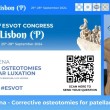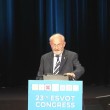
Simon Roe, BVSc, MVSt, MS, PhD, MACVSc, Diplomate ACVS
Professor, Small Animal Orthopaedic Surgery
Department of Clinical Sciences
North Carolina State University
Deputy Editor-in-Chief. VCOT
G.S-S. Please give readers a little background of your career and how you came to be involved with small animal orthopaedics.
S.R. I completed my BVSc at the University of Queensland in 1979, where my interest in surgery was started by Dr. Geoff Robins. I did an internship in surgery at the University of Melbourne, and then a residency in small animal surgery at the University of Illinois from 1982 to 1985. Dr. Ann Johnson guided my training in orthopaedics and my research project on cortical bone allograft mechanics introduced me to biomechanics. After 1 ½ years at the University of Sydney as a Surgical Registrar, I undertook a PhD at the Centre for Biomedical Engineering at the University of New South Wales. I started at North Carolina State University in 1991, and was graciously bought along by Drs. Betts and DeYoung. Multiple collaborations with the engineering and textiles groups at NCSU have further expanded by biomechanics experience.
G.S-S. Most of us develop interests in particular subjects of orthopaedics and I wonder what is exercising your mind at the moment enough to involve you in research in an area?
S.R. We have just completed a review of our first six years of uncemented total hip replacement cases using the BFX™ system. While, in general, we have been very pleased with the overall outcome, issues associated with fissure during broaching or placement of the stem or fracture of femur in the first few weeks after surgery have led me to investigate ways to reduce the risks of this complication. The fact that one potential solution involves tying wire made it even more attractive an idea, as, I’m sure you are aware, I have a small fetish associated with knots and wire.
G.S-S. Very little is understood about osteoporosis in dogs, In that patients undergoing THR are often elderly, do you think that the disease could play a part in the production of the fissures that you mention?
S.R. There are two comments related to this question. First, half of our 200 patients in the first six years were less than three years of age. The second age spike is at five to six years of age. We have done only 20 dogs older than nine years. Bone quality is one factor that influences the occurrence of fissures, and, in older dogs with advanced disease, the proximal femur may have poor trabecular quality and thin cortices. We do see a higher incidence of fracture after THR in our older population (9% in dogs older than six years). A ‘stove-pipe’ conformation to the proximal femur is also thought to predispose to fissure as the endosteal shape does not match the stem shape as well. Fissure development also seems more common when broaching is not well aligned. With our current approach to ensuring optimal broach direction, the fissure rate is much reduced from our early experience. Older dogs with poor bone quality or shape are probably best managed with a cemented stem. In younger dogs with sclerosis proximally or femoral neck deformity (and, therefore, a higher possibility of high stresses), prophylactic cerclage wiring will help protect the proximal femur from fissure.
G.S-S. What other research are you currently involved with or planning?
S.R. We have been using the Triple Tibial Osteotomy (TTO) for managing stifle instability and are generally happy with the results. However, the final shape of the tibia is not always what was planned, so we are beginning some work to evaluate the various aspects of the TTO in order to achieve a more consistent end-point, which produces the combined change in the bone morphology. This project has started with a review of our clinical cases, and will include some in vitro studies to identify the best approach to eliminating cranial thrust.
G.S-S. Simon: Just suppose you were given $2M for your research and two years of R & D; what would you do with it?
Very interesting proposal - lots of ideas came to mind, but I’ll limit it to two. First, was a fracture biomechanics idea I've been thinking about for a while. Motion at a fracture site stimulates a large fibrous callus, but too much tissue strain causes damage to the vessels and tissues in the gap. Some research has suggested that the rate of healing might be accelerated by starting with rigid fixation, and then de-stabilizing the support system to allow the callus tissue to be mechanically stimulated. What would happen if the opposite approach was taken? -- Allow a fracture to be a little unstable initially, encouraging the elements of the callus to form and then, when all the elements are there, provide more stability so that the more strain sensitive bone tissue can form without being damaged?
The second project comes from a question that I get nearly every day, but don’t have a good answer for – why did he tear his cruciate ligament? I suspect this is still a question because it is very hard to study, is probably multi-factorial, and likely requires a population-based approach – something surgeons are not particularly good at. I would initiate such a project by assembling a group of the brightest of our profession and staging a debate where each attendee is asked to make a presentation present about one possible cause, and the data that would be necessary to prove the hypothesis. Through the debate the defining questions, and the ways in which these might be answered, would be developed. This would lead to a coordinated approach from the profession to this issue, and it is to be hoped, advance our understanding of this bewildering puzzle.















